There are a few reasons why a skier might want to go snowboarding. For example, you may find skiing hard to master, fancy trying something new, like the idea of sideways sliding, or plain jealousy. Whatever your reason, I recommend that you give snowboarding a try.
Learning how to snowboard as a skier is very possible. There are a few techniques that will be alien to you, but there are also a few aspects of skiing that can make the transition to snowboarding easier. How quickly you learn to snowboard depends on your mindset, fitness, and sporting background.
In this article, I’ll go into all the aspects of learning how to snowboard for skiers and give you lots of tips to help you transition from two planks to one.
Why Would A Skier Learn To Snowboard?
Many skiers become snowboarders for various reasons. Let’s take a closer look at why they made the change.
1. Looking For A New Challenge
Experienced skiers get to a crossroads where they need to make a decision.
They can either commit to pushing their skiing abilities to progress or challenge themselves in a new way by learning how to snowboard. The decision is based on personal preferences and circumstances.
For example, their friend group may be mainly made up of snowboarders, or they believe that becoming a better skier means they will have to take it more seriously, which could ruin the fun.
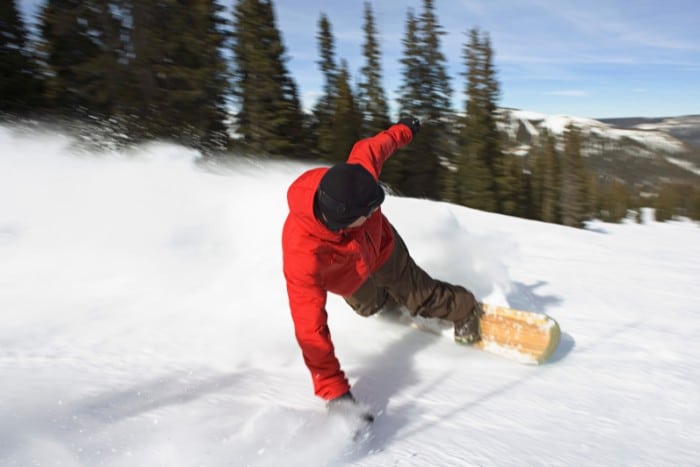
2. Mix It Up For The Snow Conditions
In previous posts, I’ve highlighted the pros and cons of skiing and snowboarding. One of the main advantages snowboarding has over skiing is how much fun they are to ride in powder.
So, if a skier can snowboard, they can leave the skis behind and have more fun on a powder day.
On the flip side, if the conditions are icy or the snow is hard-packed, they can dig the skis out and enjoy some high-speed fun.
I can ski, but I snowboard in all conditions, as I find it more fun. To make it even more fun, I choose the best board for the conditions out of my ever-expanding quiver.
3. Protect Their Knees
Skiing is not great for your knees, as they take a constant pounding. Also, the fact that your legs are independent of each other leaves your knees vulnerable to twists, causing horrific injuries.
Snowboarding isn’t exactly kind to your knees, especially when you jump off everything in sight. However, snowboarding is more forgiving on your knees than skiing.
Skiers often transition to snowboarding to continue to enjoy the mountain lifestyle but to save their knees. Sometimes snowboarding is recommended as an alternative to skiing by doctors.
How Being Able To Ski Helps You Learn How To Snowboard?
There are a few things that you can bring from skiing that will help you transition to a snowboard.
1. You Already Have Good Balance
If you can ski a little, you will have developed an element of balance, which you can take to a snowboard.
This balance comes from sliding around on slippery and uneven surfaces, which is precisely what you do on a snowboard.
It is a little more tricky, as the stance is entirely different, and your feet can’t move independently. But having some experience standing and sliding on snow is beneficial to becoming a snowboarder.
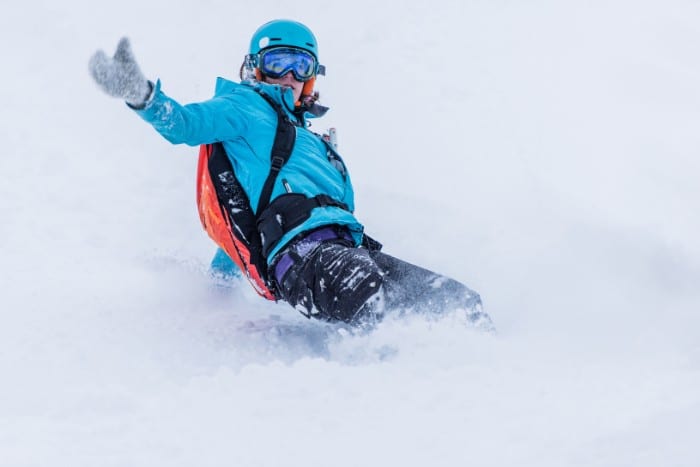
2. Snowboard Edges Work The Same As Ski Edges
Both skis and snowboards have sharp edges that grip the snow and allow you to carve.
Skiers have an advantage on icy surfaces, as they have two edges in contact with the snow, whereas a snowboarder only has one, giving them less security and control.
But the edges on both skis and snowboards do the same thing. So if you have some skiing experience, you’ll get a feel of using the edges of a snowboard much quicker than a complete winter sports virgin.
3. Knowledge Of The Snow
If you’ve spent a reasonable amount of time skiing, you’ll know how to adapt your technique to the snow conditions.
You may do this unconsciously, but you’ll ski over to the best snow and know where to turn to avoid the nasty parts.
This knowledge is very useful when you transition to snowboarding. For example, you’ll know to avoid ice patches and look for softer snow to make your turns.
4. Knowledge Of The Slopes
Beginner snowboarders can quickly get out of their depth by heading to slopes unsuitable for their ability. But as a skier, you will have a good idea of the slopes to avoid and the best ones to go to.
5. You Know How Ski Lifts Work
A ski lift can be terrifying for someone who has never been to a ski resort.
To a newbie, these strange contraptions look complicated to use, especially when you don’t yet have the basic skills of skiing or snowboarding to back you up.
But as someone who has skied before, you know how ski lifts work.
You will have to adapt to the awkwardness associated with getting on a machine designed for skiers with a snowboard on your feet, but you have a head start.
6. You Already Have Suitable Clothing
Ski and snowboard clothing have their differences. For example, snowboard pants have reinforced panels and padding to protect the areas that are in the snow a lot.
The baggier cut and design of snowboard clothing are more suited to the stance and movements too.
However, if you already have some ski clothing, you can wear it on a snowboard until you complete the transition.
You may want to buy some proper snowboard gloves, as they are more robust and keep your hands dry. This is important, as your hands will be in the snow a lot in the early days of learning how to snowboard.
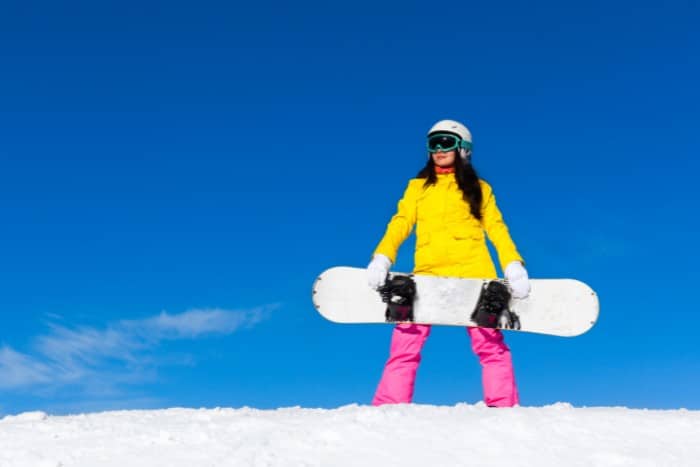
The Challenges Of Going From Skiing To Snowboarding
I’ve mentioned a few aspects of skiing that will help you in your snowboarding journey. So now it’s time to talk about the things you’ll have to overcome when learning to snowboard as a skier.
1. The Stance
The most obvious difference between skiing and snowboarding is the stance. The forward-facing stance of a skier is more natural, as this is the position we are in when running, walking, and cycling.
Standing sideways on a snowboard for someone new to board sports can be tricky to come to terms with. A surfer or skater will find standing sideways more natural, but a skier will need to get used to it.
The other aspect of the snowboard stance is working out which foot you should lead with.
Riding with your left foot forward is called riding with a “regular” stance, but “goofy” snowboarders lead with their right foot.
If you’re new to standing on a board of any kind, working out if you’re regular or goofy can be tricky. I started as a goofy rider, but after a lot of struggling, I realized I was regular.
2. Being Strapped In
Most new snowboarders find having their feet strapped to the board a challenge.
They feel restricted in the early days but learn to adapt after a while, and the feeling of being strapped to the board becomes more natural.
3. You Use New Muscles
Although skiing and snowboarding use your core and leg muscles, they use them in different ways.
After your first day of snowboarding as a skier, you’ll feel pretty sore, as you will have used muscles that haven’t had much action.
This is the same for a snowboarder that tries skiing. But whichever way you go, the more you do it, the more your muscles get used to these new movements.
4. Adapting To Ski Lifts
I’ve already mentioned that as a skier, you have a headstart in knowing how ski lifts work. However, you need to adapt, as ski lifts are pretty awkward for snowboarders, especially those new to the sport.
You first need to learn how to scoot and ride with just your front foot strapped in. This is tricky when you still need to learn how to snowboard with both feet strapped in.
The weight of a snowboard attached to one foot is uncomfortable and cumbersome to start off with.
My cousin said it’s like dragging a dead body along, which is quite a dramatic statement, but I know what she means.
Riding and scooting one-footed becomes easier the more you do it. It is an essential skill, as you need it to get on and off chairlifts and ride drag lifts.
5. Mastering Sharp Turns
When you get the knack for making sharp turns on a snowboard, you’ll find that you can tackle steeper terrain easier than on skis.
This is because snowboards are shorter than skis, allowing you to quickly turn across the fall line.
However, some skiers who go over to snowboarding tend to find this quite challenging, as the body movements are very different.
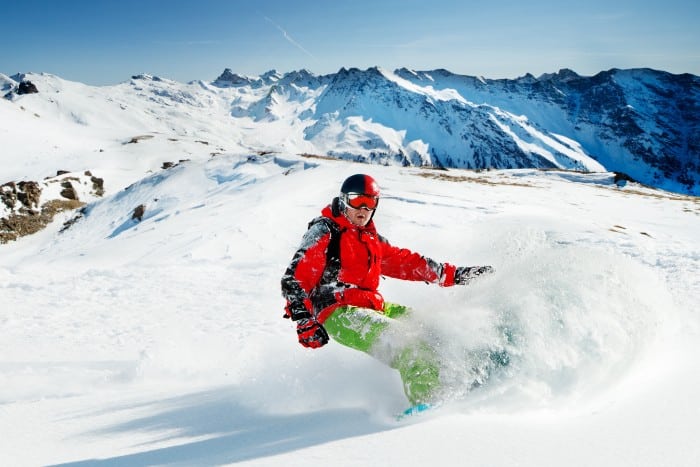
6. Keeping Momentum
Skis are faster than snowboards as they have less friction with the snow. Skiers also stand in a more aerodynamic position, allowing them to cut through the air more efficiently.
This means skiers can carry momentum along flat sections. If a skier runs out of steam on a flat section, they can push themselves along with their poles and use a skating motion to keep moving.
Flat sections are troublesome for snowboarders, especially new ones. If you’re an experienced snowboarder, you can straight-line everything to keep your speed up over the flat sections.
If snowboarders stop on a flat section, they must scoot one-footed or take their snowboard off and walk to the next slope.
This can be frustrating for a skier who has just got into snowboarding, as they wouldn’t usually have to put up with this.
7. Prepare To Be A Beginner Again
This is probably the most challenging part of going from skiing to snowboarding. Many skiers don’t bother learning how to snowboard as they don’t want to feel like a beginner again.
This is understandable, as they could be exploring exciting terrain on skis, but instead, they are just getting to grips with their first turns.
How To Go From Being A Skier To Being A Snowboarder?
OK, so now you know what you’re letting yourself in for. But there are a few things you can do to make a move away from the dark side smoother.
1. Create The Right Mindset
You need to come to terms with being a beginner again. Don’t expect to be hitting the backcountry or the black runs just yet, as you’ll find runs you can ski easily much harder on a snowboard.
You need to block this out of your mind and take baby steps until your skills allow you to take on more challenging terrain.
Start on the bunny slopes, and work your way onto the blue runs. You’ll be surprised how quickly you will progress from there, but don’t skip the easy stuff out of frustration.
2. Take A Lesson Or Two
Even if you have some experience in board sports, you’ll benefit from taking a couple of snowboard lessons.
A snowboard instructor will shorten your path to being a snowboarder by giving you the correct techniques.
This will also make you a more confident rider, allowing you to progress much more quickly than if you tried to teach yourself.
They will make your introduction to snowboarding more fun too. Snowboard instructors love to pass on their passion for the sport, especially if it means they convert another skier.
3. Work On Your Fitness
As I mentioned earlier, snowboarding uses different muscles than skiing. So, you can give yourself a head start by hitting the gym to exercise those snowboard muscles.
It would help if you had strong core muscles for snowboarding, especially as a beginner, as you’re constantly picking yourself off the snow.
Therefore, it’s a good idea to focus on strengthening your core with crunches, Pilates, and plank variations.
Snowboarders also benefit from good mobility. Therefore, you might want to take some yoga classes in the offseason to move more efficiently and with less restriction when you strap in.
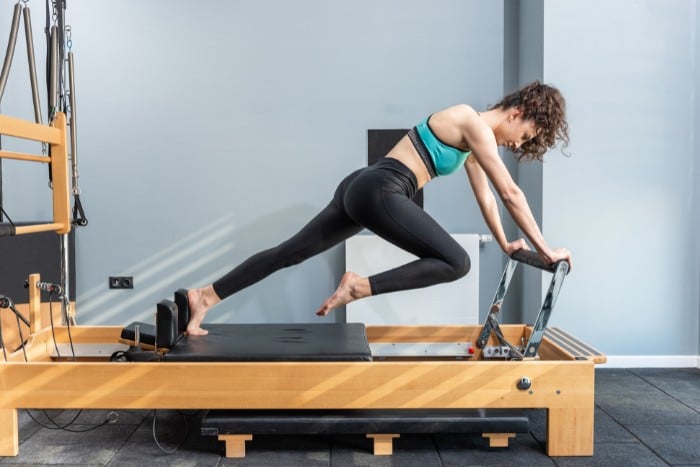
4. Manage The Risk
As a skier, you’re probably aware of the dangers of sliding down a mountain at high speed. But you can manage the risks with some protection.
You should always wear a helmet whether you’re skiing or snowboarding, but there are other ways snowboarders can protect themselves.
One of the most common things for beginner snowboarders to wear is impact shorts. You wear these padded shorts under your pants to protect your coccyx when you fall on your behind.
They also make sitting in the snow more comfortable. Beginner snowboarders are vulnerable to wrist injuries, and this is because we automatically put our hands down when we fall.
You can wear wrist protectors that absorb a lot of the impact. Wrist protectors are great, but most riders wean themselves off them as they progress.
You put your hands down less frequently when you get better at snowboarding. Some snowboarders like to wear knee pads.
These aren’t always necessary, but when you’re learning how to snowboard, your knees can get bashed up a bit. Knee pads also insulate you from the snow when kneeling, which is more comfortable.
Final Thoughts
Are you ready to leave two planks behind? Go on, try it! You may find that you have more fun on a snowboard, but you’ll never know if you don’t try.
You don’t need to label yourself as a snowboarder, but it would be cool to choose between skiing or snowboarding to ensure you have the most fun in the conditions.
